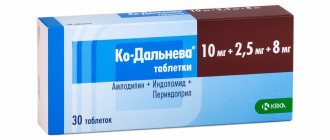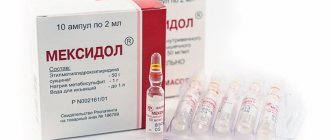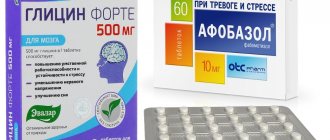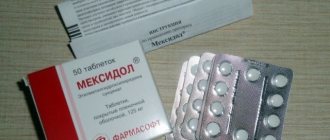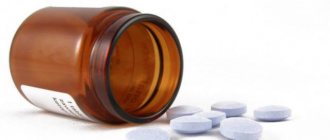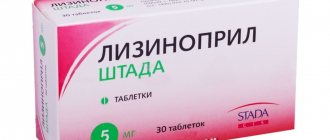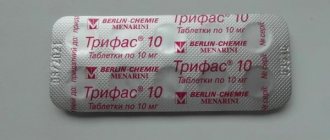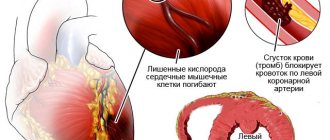0
Author of the article: Marina Dmitrievna
2017.12.15
5 790
Drugs
There are drugs that are used as cardioprotective and antihypoxic agents during intense physical activity. Such drugs include Riboxin and Mildornat.
The main purpose of the drugs is complex therapy of coronary heart disease. However, athletes often use them to achieve more pronounced athletic results.
The drugs are effective individually, but many are interested in whether Riboxin and Mildronate can be taken together.
Neuroleptics
Antipsychotics are also used to treat depression, which, in addition to their action aimed at relieving psychosis, exhibit a moderate antidepressant effect - chlorprothixene (Truxal), sulpiride (Eglonil, Dogmatil), flupentixol (Fluanxol), levomepromazine (Tizercin), rispolept (risperidone), olanzapine ( Zyprexa) as well as lithium carbonate, effective for mild to moderate depression. When depression is combined with delusions and hallucinations, atypical antipsychotics (risperidone, olanzapine) are usually combined with antidepressants (fluoxetine, mirtazepine), the effectiveness of such treatment reaches 60-70%.
Patients with signs of bipolar affective disorder are recommended to be prescribed olanzepine, since in addition to the antipsychotic effect, it also has a mood stabilizer effect.
At the same time, it should be borne in mind that in most cases, antidepressants reduce the effectiveness of antipsychotics, especially in patients in acute psychosis.
Drugs affecting the endocrine system
Currently, a number of drugs affecting the state of the hypothalamic-pituitary-adrenal system have been proposed abroad for the treatment of depression. The first group of drugs of this type includes medications that block the synthesis of cortisol at the level of enzyme systems (ketoconazole, metyrapone, aminoglutemide), which, however, have a large number of side effects that are essentially the result of long-term endocrine dysfunction (Wolkowitz O., et al. , 2001). The second group of drugs includes corticosteroid receptor antagonists (antalarmin), which have the potential effect of antidepressants and anxiolytics (Holsboer F., 1999). Currently, research is being conducted on the use of DHEA sulfate as an adjuvant therapy in the treatment of depression, in particular, for the correction of cognitive impairment in this pathology (Sapolsky R., 2000).
Reviews, recommendations
Having analyzed the reviews about the drug (Russia, Ukraine, Belarus), it can be noted that most of them are positive. A mild effect, stabilization of conditions and a general improvement in well-being were noted.
Among the negative ones, critical remarks regarding the cost prevail (price-quality ratio, aspirin is cheaper, etc.), reflections on the topic “harm and benefit”, in some cases the manifestation of side effects is noted. Someone took a dietary supplement (combined with cardiomagnyl) and did not feel any difference.
However, most of those who oppose it note that they were self-medicating, which is extremely dangerous to health. We advise you to do the right thing: undergo an examination, describe the symptoms and act according to the recommendations of specialists (compatibility with other dosage forms (injections, capsules, etc.), alcohol, etc.), how to distinguish a fake, etc. Don't forget to keep an eye on the expiration date.
Normotimics
In case of bipolar, recurrent depression, cyclothymia, schizoaffective disorder, intermittent explosive disorder, usually after stopping the acute episode and the maintenance therapy stage, mood-leveling drugs are prescribed - affect stabilizers (normotimics, thymoleptics). Affect stabilizers are also used to relieve a manic state that occurs after a stroke, injury to the frontal lobe, and cancer of this area of the brain. In addition, these drugs are occasionally used as an adjuvant treatment for a severe depressive episode (major depressive disorder), in which case they are prescribed in small doses with a gradual and slow increase in the dose of the medication.
Mexidol
Mexidol belongs to the group of antihyxants with nootropic and anxiolytic properties and an antioxidant effect. In its antihypoxic activity, Mexidol is significantly superior to piracetam and nootropil. The drug has a wide range of pharmacological activity, being an antihypoxic, stress-protective, nootropic, anticonvulsant and anxiolytic drug that inhibits free radical processes of lipid oxidation. The pharmacological effects of Mexidol are realized at three levels: neuronal, vascular and metabolic.
The therapeutic effect of Mexidol is detected from 10 to 300 mg/kg. The drug is especially indicated in the treatment of prolonged astheno-depressive syndromes; it relieves tension and anxiety, eliminates feelings of anxiety. The effectiveness of the drug in the treatment of somatovegetative disorders accompanying manifestations of depression, its ability to restore impaired circadian rhythm, and a positive effect on cognitive functions have been proven.
Mexidol can be prescribed intravenously (drip or stream), intramuscularly and orally.
Mexidol is a drug intended for the treatment of a wide range of diseases of a very different nature. It often has to be combined with drugs from other pharmacological groups. In such cases, patients have questions about how safe it is and whether any rules for co-administration need to be followed.
Let's consider the most common combinations of Mexidol with other drugs and the features of their parallel use.
Instructions for use
When the doctor has prescribed Mexidol injections for treatment, they are administered intramuscularly or intravenously using injections and droppers. When a patient is given a drip, the rate of administration of the drug does not exceed 55 drops per minute. To prepare the dropper, you need to add the Mexidol solution to the saline solution. The drug administration procedure lasts five minutes.
The course of treatment and dosage is prescribed by the attending physician after the final diagnosis. You cannot end the course of treatment abruptly; this is done gradually. That is, before the end of the course of therapy, the patient is given a reduced dose of the drug, and the doctor monitors the result. You may need another course of treatment.
The same goes for tablets. The minimum course of treatment lasts 14 days. But there is an exception, for example, treatment of alcohol addiction, then seven days will be enough for treatment.
An overdose of the drug can occur due to the large volume of the administered solution or the volume of tablets exceeding the doctor’s prescription. Often, this happens during self-medication or therapy for an incorrect diagnosis.
Overdose has also been observed during simultaneous treatment with Mexidol and other drugs. These may be antidepressants or tranquilizers. The drug Mexidol is effectively combined with drugs for the treatment of somatic diseases.
Description of Mexidol
Mexidol is a drug based on ethylmethylhydroxypyridine succinate. This is a derivative of succinic acid, which performs many important tasks in the body:
- normalizes blood circulation processes by thinning the blood;
- stimulates brain function by accelerating the transmission of nerve impulses;
- helps brain and heart cells maintain their viability longer by strengthening their membranes;
- stabilizes the functioning of the autonomic nervous system, which regulates the activity of the heart, blood vessels, and digestive tract;
- fights free radicals - active molecules that provoke cell death;
- activates metabolism and energy;
- has anti-anxiety and anticonvulsant effects, normalizes sleep.
Doctors prescribe medicine in the following situations:
- disturbances in the functioning of the autonomic nervous system – vegetative-vascular dystonia;
- vascular, traumatic, inflammatory diseases of the brain in acute or chronic form;
- prolonged stress;
- age-related disorders of memory, attention, thinking;
- increased anxiety, irritability, insomnia;
- diseases associated with oxygen starvation of the heart muscle - angina pectoris, myocardial infarction;
- consequences of alcohol and antipsychotic drug abuse;
- increase in intraocular pressure;
- purulent foci in the abdominal cavity.
pharmachologic effect
The main component of the drug has a direct effect on the nervous system, changes the composition and structure of the blood, and affects the course of metabolic processes. This leads to the development of a number of effects that have a beneficial effect on the state of the brain and the body as a whole.
Properties and types of action of the drug "Mexidol":
- nootropic – a specific effect on higher nervous functions, which leads to increased brain performance;
- antihypoxic – eliminating signs of oxygen starvation of tissues, preventing negative effects on brain cells due to oxygen deficiency;
- anxiolytic – improving a person’s mood, combating unreasonable feelings of fear and anxiety, inadequate or excessively violent emotions;
- antioxidant – cleansing tissues of toxins, removing toxins and decay products from the body;
- membrane-protective and stabilizing - preventing the destruction of cell membranes, protecting tissues from the influence of free radicals, accelerating the flow of biochemical processes.
The product has a number of additional effects, which allows it to be used not only in the presence of organic or functional problems, but also under the influence of physiological factors. The medicine helps fight the symptoms of stress, increases brain performance, and improves memory. It is used in the treatment of convulsive syndromes and is included in complex therapy for alcohol dependence.
Compatibility of Mexidol with drugs
This medicine is compatible with most medications, but sometimes with combined treatment you have to follow certain rules.
Corvalol and Mexidol, compatibility
Corvalol is a combination drug with a calming effect. It contains a potent substance, phenobarbital, the effect of which is enhanced in combination with Mexidol. It is recommended to take the drugs together for increased anxiety, mood swings, and insomnia. They relieve attacks of palpitations, lack of air, and unaccountable fear against the background of vegetative-vascular dystonia. Mexidol is usually prescribed in a standard dose, and the dosage of Corvalol is selected individually. It should be borne in mind that it is not recommended to take Corvalol for a long time due to the risk of developing side effects and addiction to phenobarbital.
Mexidol and Nicotinic acid, compatibility
Medicines can be used simultaneously; they complement each other’s action. The first has a greater effect on energy metabolism and transmission of nerve impulses, while nicotinic acid has pronounced vasodilating properties. Therefore, they are often prescribed together for vascular diseases of the brain. Simultaneous use is possible in both injection and tablet forms. No dosage adjustment is required.
Succinic acid and Mexidol - compatibility
The parallel use of succinic acid and Mexidol is inappropriate, since the latter is also based on its derivative - succinate. The drugs have similar pharmacological properties, but they are not exactly the same thing. Mexidol is considered a more active, improved drug. Its active substance is better absorbed by tissues than ordinary succinic acid, and smaller doses of the drug are needed to achieve a therapeutic effect. Although it is impossible to say unequivocally which of them is better - Mexidol or succinic acid. It depends on the body of a particular person and his susceptibility to a particular drug.
Mexidol and antidepressants - compatibility
These drugs are often prescribed together. Indications for combination therapy are prolonged anxiety depression, accompanied by asthenia (exhaustion) of the nervous system, as well as disorders of the autonomic system. In such cases, against the background of depression, the patient experiences attacks of rapid heartbeat, changes in blood pressure, digestive disorders, and insomnia.
Antidepressants directly affect depressive disorders, and Mexidol suppresses anxiety, normalizes sleep and fights autonomic disorders. When using drugs simultaneously, it is sometimes necessary to reduce the dose of antidepressants, but this decision remains with the doctor and depends on the patient’s tolerability of combination therapy.
Mexidol and Valerian - compatibility
Valerian is a popular herbal sedative, available as an extract or tincture. In combination with Mexidol, they are twice as effective in coping with anxiety, insomnia, and vegetative-vascular dystonia. Usually, treatment with these two drugs is well tolerated, but the doses for them are selected individually. If the concentration of substances in the body is too high, lethargy, lethargy, and drowsiness will appear.
Fluoxetine and Mexidol - compatibility
Fluoxetine is an antidepressant with a stimulating effect, which is used for depression with symptoms of asthenia (nervous exhaustion), as well as in elderly patients with slow mental functions and thinking. In such cases, its combination with Mexidol gives an extremely positive effect, since the latter stimulates all higher brain functions. Against the background of combination therapy, the patient’s memory, attention, thinking improves, his mood improves, and an interest in life appears. The combination of drugs is well tolerated, but in some cases dosage adjustment is necessary. This issue is always resolved individually.
Mexidol and Anaprilin - compatibility
Anaprilin is a drug that is prescribed for high blood pressure and heart rhythm disturbances. Simultaneous administration with Mexidol is indicated for panic attacks, which are often accompanied by rapid heartbeat. In such a situation, Mexidol acts as a basic therapy; it shows effects only with a course of treatment. Anaprilin is prescribed one-time as an “ambulance” to slow down the heart rate.
It should be remembered that when these drugs are taken in combination, they may have a depressing effect on the brain. Therefore, it is better to start using Anaprilin with 20 mg, increasing the dose if necessary.
Side effects
The positive properties of the drug include the fact that it is not addictive; it can be canceled at any time without fear of consequences. But since Mexidol has recently been used, contraindications, side effects and features of its use for various diseases have not yet been studied enough. The drug is considered safe and has almost no toxic effect on the body. The only side effects observed were:
- allergic reactions due to individual intolerance;
- nausea, dryness and metallic taste in the mouth when administered intravenously;
- severe drowsiness, impaired coordination of movements and decreased activity in case of overdose.
All these consequences pass quickly and usually do not require discontinuation of the drug, with the exception of allergic reactions.
Release form, composition and packaging
Film-coated tablets from white to off-white with a creamy tint, round, biconvex.
| 1 tab. | |
| ethylmethylhydroxypyridine succinate | 125 mg |
Excipients: lactose monohydrate - 97.5 mg, povidone - 25 mg, magnesium stearate - 2.5 mg.
Film shell composition: opadry II white 33G28435 - 7.5 mg (hypromellose - 3 mg, titanium dioxide - 1.875 mg, lactose monohydrate - 1.575 mg, polyethylene glycol (macrogol) - 0.6 mg, triacetin - 0.45 mg).
10 pieces. — cellular contour packages (1) — cardboard packs. 10 pieces. — contour cell packaging (2) — cardboard packs. 10 pieces. — cellular contour packages (3) — cardboard packs. 10 pieces. — contour cell packaging (4) — cardboard packs. 10 pieces. — contour cell packaging (5) — cardboard packs.
